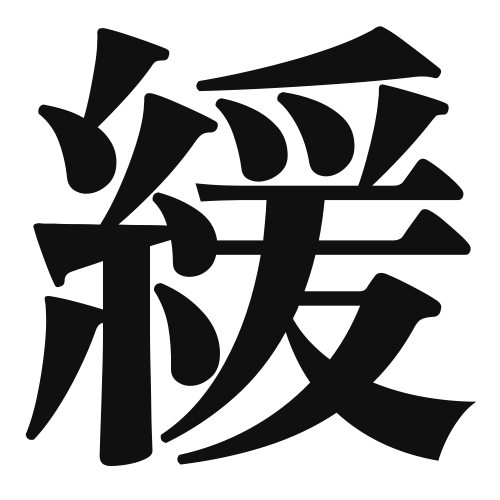1. Overview of Meaning
The kanji “緩” (pronounced “kan” or “yuraka”) means “loose,” “gentle,” or “slow.” It conveys a sense of relaxation or a lack of tension, often used in contexts related to physical looseness or a gentle approach to situations.
2. Formation and Radical
Formation of the Kanji: The kanji “緩” is a compound character (会意文字) that combines the elements of “糸” (thread) and “緩” (to loosen). This combination suggests the idea of loosening threads or fibers, symbolizing a gentle or relaxed state.
Radical: The radical of “緩” is “糸” (ito), which relates to threads or strings, indicating its connection to textiles and the concept of looseness.
3. Examples of Usage
Common Words and Phrases: Some frequently used words that include “緩” are:
- 緩和 (かんわ, kanwa) – alleviation, relaxation
- 緩やか (ゆるやか, yuruyaka) – gentle, gradual
Example Sentences in Daily Conversation:
- このベルトは少し緩いです。 (このベルトはすこしゆるいです。) – This belt is a bit loose.
- 彼の話し方はとても緩やかです。 (かれのはなしがたはとてもゆるやかです。) – His way of speaking is very gentle.
4. Synonyms and Antonyms
Similar Kanji: A similar kanji is “緊” (きん, kin), which means “tight” or “tense.” While “緩” suggests looseness, “緊” conveys the opposite idea of being tight or under pressure.
Antonyms: The antonym of “緩” is “厳” (げん, gen), meaning “strict” or “severe,” which represents a rigid or tense state.
5. Cultural and Historical Background
Relation to Japanese Culture: The concept of “緩” is significant in Japanese culture, where balance and harmony are valued. It reflects the importance of a gentle approach in various aspects of life, including communication and relationships.
Proverbs and Idioms: One common saying is “緩急をつける” (かんきゅうをつける, kankyuu wo tsukeru), which means “to adjust the pace,” emphasizing the importance of knowing when to be relaxed and when to be strict or urgent.
